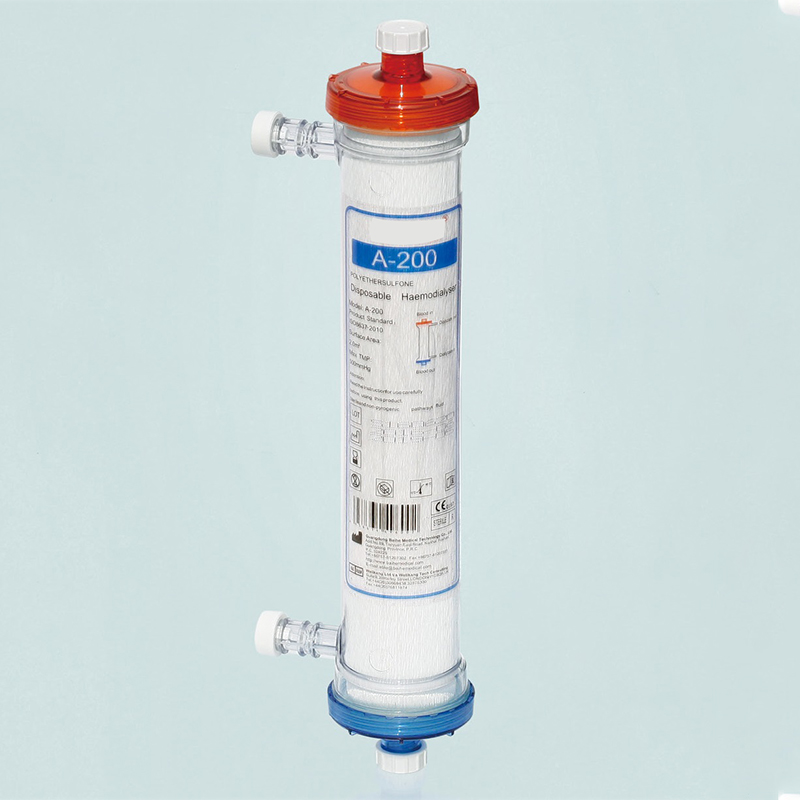Introduction
In the management of end-stage renal disease (ESRD) and acute kidney injury (AKI), the dialyzer—often called the “artificial kidney”—is the core medical device that removes toxins and excess fluid from the blood. It directly impacts treatment efficiency, patient outcomes, and quality of life. For healthcare providers, selecting the right dialyzer is a balance between clinical goals, patient safety, and cost. For patients and families, understanding the differences among dialyzer types helps them participate in shared decision-making.
This article breaks down the main categories of dialyzers, their technical features, and practical selection strategies based on modern guidelines such as KDIGO.
Core Classification of Dialyzers
Modern hemodialysis dialyzers can be classified by four main dimensions: membrane material, structural design, functional characteristics, and patient-specific considerations.
1. By Membrane Material: Natural vs. Synthetic
Cellulose-based (Natural) Membranes
Traditionally made from cellulose derivatives such as cuprophane or cellulose acetate, these membranes are low-cost and widely available. However, they have limited biocompatibility, can trigger complement activation, and may cause fever or hypotension during dialysis.
Synthetic (High-Performance) Membranes
Composed of high-grade polymers like polysulfone (PSu), polyacrylonitrile (PAN), or polymethyl methacrylate (PMMA). These membranes offer controlled pore size, higher middle-molecule clearance, and superior biocompatibility, reducing inflammation and improving patient tolerance.
2. By Structural Design: Hollow Fiber vs. Flat Plate
Hollow Fiber Dialyzers (≥90% of clinical use)
Contain thousands of fine capillary fibers with large surface area (1.3–2.5 m²) and low priming volume (<100 mL). They provide high-efficiency clearance while maintaining stable blood flow dynamics.
Flat Plate Dialyzers
Rarely used today, these have smaller membrane areas (0.8–1.2 m²) and higher priming volumes. They are reserved for special procedures such as combined plasma exchange and dialysis.
3. By Functional Characteristics: Low Flux vs. High Flux vs. HDF-Optimized
Low Flux Dialyzers (LFHD)
Ultrafiltration coefficient (Kuf) <15 mL/(h·mmHg). Primarily remove small solutes (urea, creatinine) via diffusion. Cost-effective, but with limited middle-molecule clearance (β2-microglobulin <30%).
High Flux Dialyzers (HFHD)
Kuf ≥15 mL/(h·mmHg). Allow convective clearance of larger molecules, reducing complications such as dialysis-related amyloidosis and improving cardiovascular outcomes.
Hemodiafiltration (HDF)-Specific Dialyzers
Designed for maximal middle-molecule and protein-bound toxin removal, often combining high-permeability synthetic membranes with adsorption layers (e.g., activated carbon coatings).
4. By Patient Profile: Adult, Pediatric, Critical Care
Standard Adult Models: 1.3–2.0 m² membranes for most adult patients.
Pediatric Models: 0.5–1.0 m² membranes with low priming volume (<50 mL) to avoid hemodynamic instability.
Critical Care Models: Anticoagulant coatings and very low priming volume (<80 mL) for continuous renal replacement therapy (CRRT) in ICU patients.
Deep Dive into Major Dialyzer Types
Natural Cellulose Membranes
Features: Affordable, well-established, but less biocompatible; higher risk of inflammatory reactions.
Clinical Use: Suitable for short-term support or in settings where cost is the main concern.
Synthetic High-Performance Membranes
Polysulfone (PSu): A typical high flux dialyzer material, widely used in both high-flux hemodialysis and HDF.
Polyacrylonitrile (PAN): Noted for strong adsorption of protein-bound toxins; useful in patients with hyperuricemia.
Polymethyl Methacrylate (PMMA): Balanced solute removal across molecular sizes, often used in diabetic kidney disease or bone-mineral disorders.
Matching Dialyzer Selection to Clinical Scenarios
Scenario 1: Maintenance Hemodialysis in ESRD
Recommended: High flux synthetic dialyzer (e.g., PSu).
Rationale: Long-term studies and KDIGO guidelines support high-flux membranes for better cardiovascular and metabolic outcomes.
Scenario 2: Acute Kidney Injury (AKI) Support
Recommended: Low flux cellulose or budget synthetic dialyzer.
Rationale: Short-term therapy focuses on small-solute clearance and fluid balance; cost efficiency is key.
Exception: In sepsis or inflammatory AKI, consider high flux dialyzers for cytokine removal.
Scenario 3: Home Hemodialysis (HHD)
Recommended: Small-surface-area hollow fiber dialyzer with automated priming.
Rationale: Simplified setup, lower blood volume requirements, and better safety for self-care environments.
Scenario 4: Pediatric Hemodialysis
Recommended: Customized low-volume, biocompatible synthetic dialyzers (e.g., PMMA).
Rationale: Minimizing inflammatory stress and maintaining hemodynamic stability during growth.
Scenario 5: Critically Ill ICU Patients (CRRT)
Recommended: Anticoagulant-coated, low-volume synthetic dialyzers designed for continuous therapy.
Rationale: Reduces bleeding risk while maintaining effective clearance in unstable patients.
Future Trends in Dialyzer Technology
Improved Biocompatibility: Endotoxin-free membranes and bio-inspired endothelial coatings to reduce inflammation and clotting risks.
Smart Dialyzers: Built-in online clearance monitoring and algorithm-based anticoagulation control for real-time therapy optimization.
Wearable Artificial Kidneys: Flexible hollow fiber membranes enabling portable, 24-hour dialysis for patient mobility.
Eco-Friendly Materials: Development of biodegradable membranes (e.g., polylactic acid) to reduce medical waste.
Conclusion
Choosing a hemodialysis dialyzer is not merely a technical decision—it is an integration of patient condition, treatment goals, and economic considerations. ESRD patients benefit most from high flux dialyzers to minimize long-term complications. AKI patients may prioritize cost and simplicity. Children and critical-care patients require carefully tailored devices. As innovation advances, tomorrow’s dialyzers will be smarter, safer, and closer to natural kidney function—improving both survival and quality of life.
Post time: Sep-08-2025








